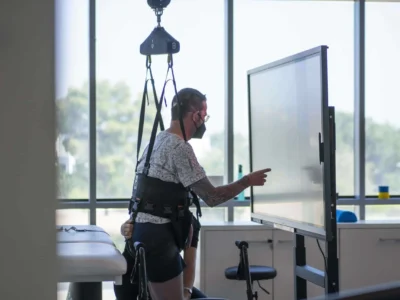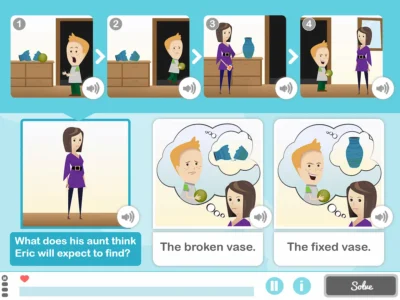Yolanda Virué Lapuente, an occupational therapist with clinical experience in managing adults with Multiple Sclerosis, shows us in this article which interventions may be the most effective, with greater adherence and optimal duration, using new technologies applied to cognitive functions in patients with multiple sclerosis.
What is multiple sclerosis?
Multiple sclerosis is an inflammatory, demyelinating and neurodegenerative disease whose target is the myelin of the central nervous system, which is damaged by the formation of plaques or inflammatory lesions that subsequently lead to scarring (gliosis) and consequent demyelination, causing the signs and symptoms of the disease.
Although multiple hypotheses have been proposed, the cause of the disease is not known with certainty. Attempts have been made to find the origin of the causes and development of this disease in environmental factors, viral factors, genetic background and immunological factors, without yet finding a clear and objective answer.
Demyelination affects multiple locations in the central nervous system, leaving sclerosis plaques in the white matter, hence the name multiple sclerosis. This demyelination process produces an alteration in the saltatory conduction of myelinated pathways, slowing and even blocking the conduction of the nerve impulse.

Subscribe
to our
Newsletter
Epidemiology
The most recent prevalence studies indicate that the detection of multiple sclerosis has increased considerably worldwide in recent decades. In Spain multiple sclerosis affects around 55,000 people, being a region of medium-high prevalence of the disease across its territory. In Europe the figure is around 770,000 and, worldwide, it is estimated that about 2,500,000 people suffer from it. Multiple sclerosis is the most common non-traumatic disabling neurological disorder in young adults. Its onset occurs at young ages, around 30 years old, predominantly affecting women in a ratio of three out of four people.
Clinical forms
Multiple sclerosis is usually classified based on its course, with three types described:
- Recurrent-remitting (RR), which is the most frequent, occurs in 85% of cases. Symptoms appear within hours or a few days and after a total or partial remission, the patient remains without further clinical manifestations for a variable period that may last months or years. Subsequently they relapse again, this process repeating successively.
- Primary progressive (PP), which occurs in 15% of patients, means that the disease advances without relapses from the onset with stabilizations and temporary improvements, but disability continues to worsen gradually over time.
- Secondary progressive (SP), which occurs in 10% of patients, initially presents as relapsing-remitting and subsequently evolves slowly and progressively. It is more common above the age of 40.
And the clinically isolated syndrome, which does not yet meet the criteria to be considered a diagnosis of multiple sclerosis and therefore some do not consider it a type. It refers to a first episode of neurological symptoms caused by inflammation and demyelination in the central nervous system, with complete or partial recovery.
Functional implications
Multiple sclerosis, by affecting any part of the central nervous system, causes multiple symptoms in the neurological sphere. Its course is usually fluctuating, but without treatment it typically leads to varying degrees of disability, which in a high percentage of cases prevents the normal or habitual performance of activities of daily living. In addition, considering the age at which it appears makes its impact very significant from a personal, family and social point of view, interfering with life development and altering plans during the most active phase of people’s lives.
Numerous studies report that cognitive impairment is present in 40 to 70% of patients with multiple sclerosis, affecting processing speed, attention, memory and executive functions. And although the chronic phases of the disease are more frequently associated with cognitive impairment, some recent studies have shown that this impairment can be detectable from the onset of the disease.
All these alterations of cognitive functions in patients significantly affect their occupations, such as activities of daily living, potentially having a significant impact on employment and quality of life, depending on the impairment and the state of the disease.
Some activities of daily living in which patients with multiple sclerosis may experience difficulties include selecting clothing appropriate for the weather, knowing where to place the utensils needed for hygiene or following the appropriate steps to properly transfer from the wheelchair to the bed, among others. In instrumental activities of daily living, there are difficulties in adjusting the speed of the electric wheelchair to environmental conditions, calculating change when making a purchase, etc. In the work area they may have problems in actively searching for employment.
Types of intervention using new technologies
Most of the intervention strategies addressed in many studies are through video games and home-based computers stimulating cognitive functions such as working memory, attention, processing speed and visuospatial skills, showing very high treatment adherence (more than 90%) and improvements in the cognitive functions studied.
- Video games: we find interventions in which they generally used tablets and video game consoles with which participants played video games controlled in real time and which adapted to each participant’s level so that it posed a challenge at all times. As in De Giglio’s study with the Italian version of Nintendo’s Dr. Kawashima’s Brain Training.
- Computer: at home, also providing all the necessary accessories and assistance from a technician in order to resolve possible problems or incidents. They were visually attractive games, with a brief instruction at the beginning of each exercise, adaptive and adjustable in difficulty depending on the participant’s improvement.
Conclusions
This article aims to bring together the different resources and tools that have been used in various studies and that have examined their effects for the different professionals who, in their daily work, are dedicated to the rehabilitation of patients with multiple sclerosis. The purpose is to offer them more innovative options, based on new technologies, so that they can apply them when carrying out their treatments, taking advantage of everything these can offer.
We are at a moment in which new lines of treatments for patients with multiple sclerosis are emerging strongly, which take advantage of new technologies not only to address symptoms but also to overcome barriers often related to distance, availability or cost to the patient, which allow them to receive treatment in a much simpler way. In addition, it is important to consider how the type of treatment, by the medium in which it is delivered, with a computer, a video game console, etc., is perceived by the patient as a game that achieves greater motivation and adherence to treatment.
Because of all the above, the results show a more significant improvement in treatments that included the use of video games and computers with exercises that progressively adapted to the improvement perceived by the patient.
This type of treatment also corresponds to those that show greater adherence by patients because they are considered more attractive, more personalized and adapted to their needs.
Regarding the optimal duration of treatment with the aim of being able to detect significant improvements derived from it, all the treatments studied have a duration of between six and twelve weeks, with eight weeks being the most recurrent time and understood to be sufficient to appreciate those improvements.
Bibliography
- Bove, R., Rowles, W., Zhao, C., Anderson, A., Friedman, S., Langdon, D., Alexander, A., Sacco, S., Henry, R., Gazzaley, A., Feinstein, A., &Anguera, J. A. (2021). A novel in-home digital treatment to improve processing speed in people with multiple sclerosis: A pilot study. MultipleSclerosisJournal, 27(5), 778-789. https://doi.org/10.1177/1352458520930371
- Cano de la Cuerda, R., and Collado Vázquez, S. (2012). Neurorehabilitation (1st ed.). Editorial Médica Panamericana.
- Charvet, L., Shaw, M., Haider, L., Melville, P., & Krupp, L. (2015). Remotely-delivered cognitive remediation in multiple sclerosis (MS): protocol and results from a pilot study. Multiple Sclerosis Journal – Experimental, Translational and Clinical. https://doi.org/10.1177/2055217315609629
- Charvet, L.E., Yang, J., Shaw, M.T., Sherman, K., Haider, L., Xu, J., & Krupp, L.B. (2017). Cognitive function in multiple sclerosis improves with telerehabilitation: Results from a randomized controlled trial. PLoS ONE 12(5), Article e0177177. https://doi.org/10.1371/journal.pone.0177177
- Custodio, N., Montesinos, R., López-Góngora, M. (2018). Cognitive impairment in patients with multiple sclerosis. An Fac med.;79(4):338-45. http://dx.doi.org/10.15381/anales. v79i4.15641
- De Giglio, L., De Luca, F., Prosperini, L., Borriello, G., Bianchi, V., Pantano, P., &Pozzilli, C. (2015). A Low-Cost Cognitive Rehabilitation With a Commercial Video Game Improves Sustained Attention and Executive Functions in Multiple Sclerosis: A Pilot Study. Neurorehabilitation and Neural Repair, 29(5), 453–461. https://doi.org/10.1177/1545968314554623
- De Giglio, L., Tona, F., De Luca, F., Petsas, N., Prosperini, L., Bianchi, V., Pozzilli, C., &Pantano, P. (2016). Multiple Sclerosis: Changes in Thalamic Resting-State Functional Connectivity Induced by a Homebased Cognitive Rehabilitation Program. Radiology: Vol 280: Number 1.
- Esclerosis Múltiple España. (n.d.). What is Multiple Sclerosis. Esclerosis Múltiple España. Retrieved March 31, 2024 from https://esclerosismultiple.com
- Lamargue, D., Koubiyr, I., Deloire, M., Saubusse, A., Charre-Morin, J., Moroso, A., Coupé, P., Brochet, B., &Ruet, A. (2020). Effect of cognitive rehabilitation on neuropsychological and semiecological testing and on daily cognitive functioning in multiple sclerosis: The REACTIV randomized controlled study. Journal of the neurological sciences, 415, 116929. https://doi.org/10.1016/j.jns.2020.116929
- Maggio, M. G., De Luca, R., Manuli, A., Buda, A., FotiCuzzola, M., Leonardi, S., D’Aleo, G., Bramanti, P., Russo, M., &Calabrò, R. S. (2020). Do patients with multiple sclerosis benefit from semi-immersive virtual reality? A randomized clinical trial on cognitive and motor outcomes. Applied neuropsychology. Adult, 1–7. Advance online publication. https://doi.org/10.1080/23279095.2019.1708364
- Máximo Bocanegra, N. (2007). Neurorehabilitation in multiple sclerosis (1st ed.). Editorial Universitaria Ramón Areces.
- Sistiaga, A., Castillo-Triviño, T., Aliri, J., Gaztañaga, M., Acha, J., Arruti, M., Otaegui, D., and Olascoaga, J. (2014). Cognitive performance and quality of life in multiple sclerosis in Gipuzkoa. Rev Neurol; 58: 337-44.
- Stuifbergen, A. K., Becker, H., Perez, F., Morrison, J., Brown, A., Kullberg, V., & Zhang, W. (2018). Computer-assisted cognitive rehabilitation in persons with multiple sclerosis: Results of a multi-site randomized controlled trial with six month follow-up. Disability and health journal, 11(3), 427–434. https://doi.org/10.1016/j.dhjo.2018.02.001
- Universidad Francisco de Vitoria (2020). White Paper on Multiple Sclerosis in Spain
- Virué Lapuente, Y. (2021). Systematic review: Benefits of applying new technologies in cognitive treatments in patients with Multiple Sclerosis [Master’s thesis, Facultad Padre Ossó]
If you liked this article about how new technologies produce benefits in cognitive treatments in patients with multiple sclerosis, you will surely be interested in these NeuronUP articles:
“This article has been translated. Link to the original article in Spanish:”
Cómo las nuevas tecnologías producen beneficios en los tratamientos cognitivos en pacientes con esclerosis múltiple







 Worksheet for developing sustained attention in children: The Missing Number
Worksheet for developing sustained attention in children: The Missing Number
Leave a Reply